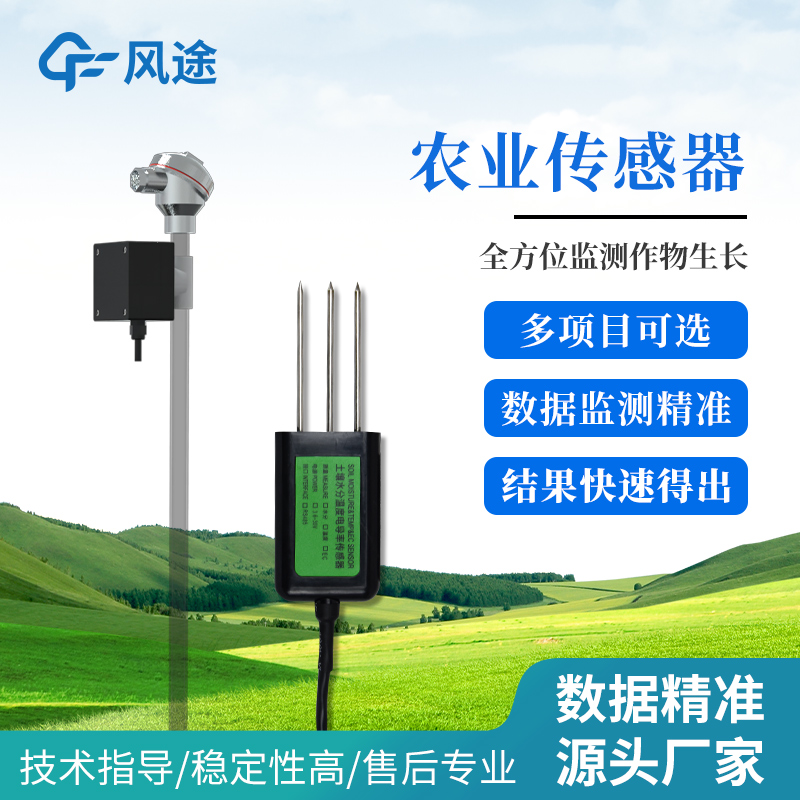Shandong Fengtu IOT Technology Co., Ltd
Sales Manager:Ms. Emily Wang
Cel,Whatsapp,Wechat:+86 15898932201
Email:info@fengtutec.com
Add:No. 155 Optoelectronic Industry Accelerator, Gaoxin District, Weifang, Shandong, China

Sales Manager:Ms. Emily Wang
Cel,Whatsapp,Wechat:+86 15898932201
Email:info@fengtutec.com
Add:No. 155 Optoelectronic Industry Accelerator, Gaoxin District, Weifang, Shandong, China
time:2024-06-14 08:39:54 source:Weather Station viewed:524 time
With rapid industrialisation and urbanisation, there is a growing concern about crop yields and health. Online monitoring of the soil environment is crucial for improving agricultural yields and ensuring the safety of agricultural products.
So there are compact, well sealed soil monitoring sensors on the market, these sensors can be buried in the soil for a long time, rapid response and efficient transmission of soil temperature, humidity and other data, to provide reliable data support for soil management and protection, to help achieve sustainable development of agriculture.
Now let's take a look at what are the soil sensors.
1. Soil temperature and humidity sensor
●The ability to continuously measure soil temperature in real time provides data support for key growth stages such as seed germination, root development, microbial activity and nutrient uptake, helping to improve crop growth rates and nutrient utilisation efficiency.
● By accurately measuring soil moisture, the soil moisture sensor provides a scientific basis for irrigation. Timely and appropriate irrigation can prevent hypoxia and disease caused by high soil moisture or crop growth restriction caused by low moisture, ensuring healthy crop growth while effectively saving water.
2. Soil conductivity sensor
Assessing the salt content of soil by measuring the conductivity of the soil solution plays an important role in determining soil salinity and salt accumulation problems. It not only helps farmers and agricultural experts to understand the health of the soil, but also guides irrigation and fertilisation strategies to avoid high soil salinity affecting crop growth. With this data, measures can be taken to improve the soil and promote crop growth under optimal conditions, increasing the efficiency and sustainability of agricultural production.
3. Soil PH Sensor
Monitoring the pH of the soil is essential for assessing soil health. Real-time monitoring of soil PH can help determine if the soil is contaminated and take appropriate measures to restore soil health. With soil PH sensors, farmers can adjust soil pH to meet the growing needs of different crops, optimise fertiliser use, and improve crop yield and quality. Meanwhile, continuous monitoring of soil pH helps to maintain the stability of soil structure and ecosystem, and safeguard the long-term fertility of the soil.
4. Soil Nitrogen, Phosphorus and Potassium Sensor
Real-time measurements of nitrogen, phosphorus and potassium levels in the soil are essential to ensure that plants receive the nutrients they need, increase crop yields and maintain agricultural sustainability. With this data, farmers can implement more precise fertilisation strategies to ensure soil nutrient balance, while reducing environmental pollution caused by excessive fertiliser use and promoting resource conservation and ecological protection. Such monitoring not only improves agricultural productivity, but also helps crops grow healthier while contributing to environmental protection.
5. Soil All-in-One Sensor
The Integrated Soil Sensor is an easy-to-install device that accurately measures key parameters such as temperature, humidity and salinity of the soil. It is suitable for a variety of agricultural and environmental monitoring scenarios, helping to improve irrigation efficiency, optimise crop management and support sustainable agricultural practices.
The widespread use of soil sensors marks a major step forward in agricultural technology. They provide farmers and researchers with the ability to gain a deeper understanding of soil conditions to guide more precise planting and irrigation practices. As technology continues to advance, these sensors will further enhance the intelligence and sustainability of agricultural production, helping us build a more efficient and environmentally friendly agro-ecosystem.

For floriculture, it is very important to do a good job of climate control, because flowers are "depending on the weather", only to create a suitable weather environment, flowers can grow robustly and bloom smoothly.Temperature is very important in flower growth and development, affecting...
Shandong Fengtu Internet of Things is a weather station equipment manufacturer, dedicated to the research and development, production and sales of various weather station equipment. The company was established in 2017 and is located in Weifang, the beautiful capital of kites. Mainly engaged in meteo...
As the air quality problem becomes increasingly serious, real-time monitoring of air quality is particularly important. By building micro-monitoring stations, we can achieve real-time monitoring of air quality and timely detection of sources of pollution in the atmosphere. The application of this te...
Soil erosion refers to the process in which soil minerals, organic matter, and substances dissolved in water are dispersed, transported, and deposited under the action of water, wind, gravity, and human factors. Its hazards are multifaceted. On the one hand, it leads to a decline in soil fertility,...